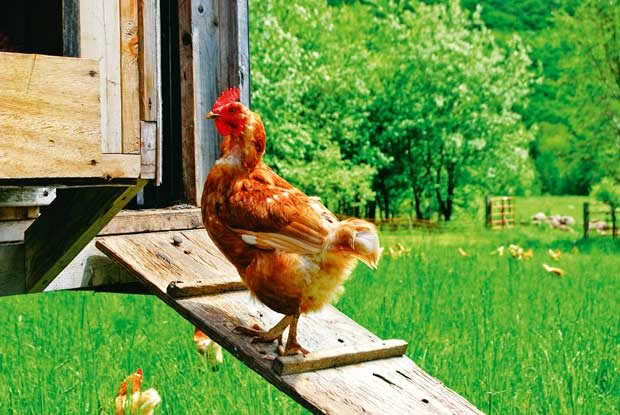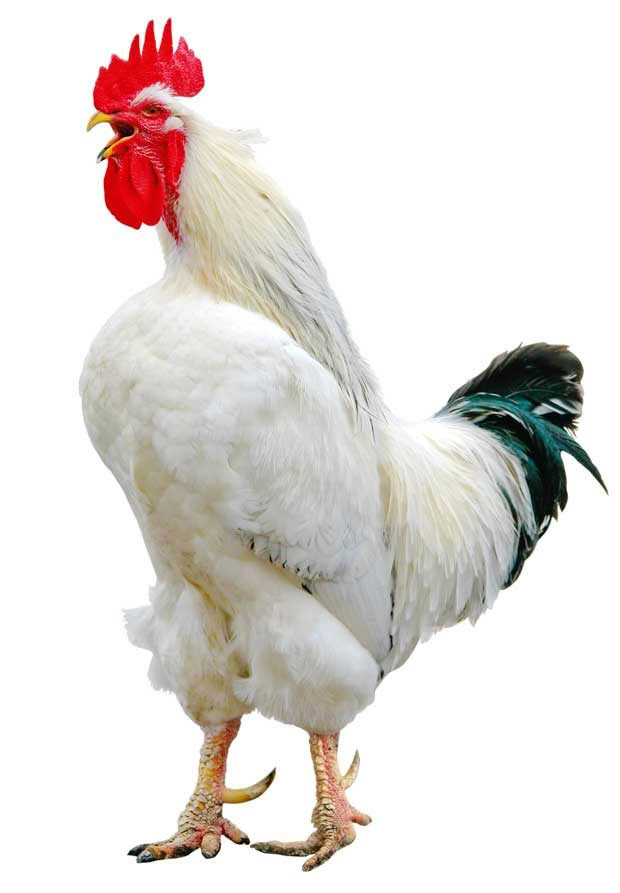Summer parasite control for hens

As temperatures and humidity rise, so do the creepy crawlies in and around your hen house. These are some ways to get rid of pests the natural way.
WORDS: SUE CLARKE
Summer is the peak season for parasites, the most common pests you’ll find irritating your poultry.
There are the internal parasites including roundworm, gape worm and tapeworm, the protozoa invaders like coccidiosis and blackhead, and the external creepy crawlies like red mite, scaly leg mite, northern fowl mite, lice and possibly fleas as well.
All are most commonly found in or on birds with free range access, whether it’s an enclosed run or in a garden, orchard or pasture. Commercial farmers whose birds are kept indoors either in cages or barns rarely have problems with parasites as their birds are kept secure from the influence of wild birds and other risks. If you take on birds from these farms, they can be more at risk (see box above) than a bird raised in a free-range environment.
Don’t forget about rodents either, one of the biggest carriers of diseases and parasites into your coop.
Spring and summer are warm, and often wet too, the ideal conditions to encourage disease. It’s also the time when you have lots of young birds around. Their juvenile immune systems are only just developing, and if they then meet a massive population boom of mites or coccidiosis, it can often be too much for them to cope with. If they are debilitated through anaemia caused by blood-thirsty parasites they will be unable to grow properly or to resist more serious viral or bacterial infections which may also be in their environment.
DEATH TO PESTS
There are chemical treatments for getting rid of unwanted ‘guests’ and most of them can destroy the invaders with a single treatment.
However, there are also a few ways that involve readily available natural remedies you can grow, sprinkle around in the coop or add to food or water which provide an ongoing deterrent. These natural methods are not as 100% effective as a specific, over-the-counter chemical product. Some don’t really kill the pest in question, but their use helps to build a bird’s immune system to such a level that it can better withstand a mild influx of parasites without suffering any ill effects. A chemical that wipes out a population of parasites with one treatment is going to be out of a bird’s system by the time the next challenge arrives, so having your birds healthy and strong all the time using ongoing natural products makes sense.
WORMING PRODUCTS
There are some excellent chemical wormers available to buy, but most have an egg withholding period so the best strategy is to use them to give your flock a ‘clean out’ once or twice a year when the hens are not laying (late winter, later summer).
You may also need a specific wormer for some types of parasites, such as gapeworm, eg Flubenol or Aviverm (for large birds). The most common off-label wormer is oral ivermectin (Eprinex® pour-on for cattle), used at a rate of 0.1ml (1 drop) per kilogram of bodyweight, placed on the bare skin underneath the wing.
Note: this should not be fed to the bird, only applied to the skin.
NATURAL PRODUCTS

There’s not a lot of scientific information to go on when it comes to natural options to help suppress internal parasite populations.
For example, a popular natural choice is chopped green pumpkin seeds, which contain a chemical called cucurbitacin which is said to affect internal worm burdens.
Some trials show good results in sheep and goats, others no difference. There is no research (yet) into their efficacy in poultry, so it’s not possible to know whether it works or not, as poultry physiology is very different to that of livestock like sheep and goats.
The other issue is the amount of cucurbitacin found in pumpkin seeds varies greatly depending on the variety of pumpkin, the time of year it is harvested and how it is then processed. Any old pumpkin seed will not do the trick.
And even if does have an effect on parasites, there is no advice on what variety is best to use, how to maintain the levels of cucurbitacin to best effect, or how much is effective.
Wormwood (Artemesia absinthium) is a herb traditionally used for its vermifugal properties (killer of internal parasites). Research has shown its use can kill up to 94% of barbers pole worms in sheep and goats, and it is a key ingredient in a NZ product called BetaDrench.
However, again, there’s no science to show whether it has the same effect on poultry. Wwormwood can be toxic so it’s not something to be recommended, especially when there are no known safe dose rates, or even a preferred way of feeding it to birds, eg dried, powdered, fresh.
MITES AND LICE
Red mites (which live on the coop, not on the bird) and the various other insect species like scaly leg mite, fowl mites, lice and fleas, can easily infest your coop and are often very difficult to get rid of. They are easily spread by wild birds infiltrating your run, and can even directly move from wild birds to your flock. You may also inadvertently introduce them when you bring in new birds or equipment which are carrying the mites, eggs or larva.
Mite eggs are very resistant and can survive for up to two years in the environment, waiting until a suitable host comes along.
A chemical insecticide treatment like Ripcord, when used properly, is probably the most effective control method if you have an infestation. If aromatic plants and herbs are also used on a regular basis (see below), you may be able to keep the population of crawlies at a reduced level. Spraying the coop and perches and nests with neem oil is also useful as oil suffocates insects.
SCALY LEG MITE

These buggers get a special mention. This is an external mite that burrows under the scales of the legs of poultry (the rooster pictured above has a bad infestation), and sometimes into the skin around the face, lifting the scales, and slowly encrusting their legs.
If the scales look like they have lifted , your birds probably have scaly leg mite. It is particularly hard to treat using an insecticide, although a topical product like ivermectin pour-on (see below) can help.
The best way to get rid of it is to combine something like an application of ivermectin, and physical suffocation of the mites. Petroleum jelly or another greasy product works well: spread it thickly and thoroughly over all scaly parts of the hen’s body using an old toothbrush so you get it deep into any crevices. You will need to repeat this every day or two over at least a week as it will be rubbed off as a bird moves around. An insecticide like neem oil can be added to the jelly, or sprayed on the legs first. There are a couple of sprays on the market that may also have insecticidal and healing properties.
15+ COMMON NASTIES YOU’LL FIND IN THE HEN HOUSE
External pests: red mite, scaly leg mite, poultry lice, poultry or cat fleas, ticks
Internal parasites: roundworm, gapeworm, tapeworm, caecal worm
Protozoan infections: coccidiosis, blackhead
Other insects: lesser mealworm beetle (which can eat its way through polystyrene insulation), ants, spiders, mosquitos, various types of flies
Mammals: rats, mice
5 WAYS TO USE HERBS IN THE HEN HOUSE
Plants you can grow which have deterrent properties include:
• lavender
• rosemary
• lemongrass
• mint
• thyme
• sage
• oregano
• wormwood
1. Pick the sprigs and hang them in the coop from the perches or by the nests and replenish regularly, throwing the wilted ones in nest litter.
2. Pick leaves of any of these and sprinkle amongst the litter in the nests to discourage red mites.
3. Pick branches of pine and lay around the walls which is said to deter rats and mice, but if it doesn’t, it will make the place smell nice anyway!
4. Mint planted around the chicken run is said to deter rats and mice.
5. The use of spices like cinnamon, nutmeg and cloves sprinkled in the nests and along the perches is also said to be a mite and lice deterrent.
Garlic and vinegar (usually apple cider) are often recommended as natural cures for worm and mite infestations, but there is no scientific proof that they work. What scientific testing has found is that treating a flock’s water supply with either cider or white vinegar (5ml to 5 litres of water) for a couple of days each month will assist gut health, which in turn aids a bird’s resistance to parasitic invaders. It acts by altering the pH of the gut contents but the reason you can’t use it continuously because it will also kill off the ‘good’ gut bacteria necessary for healthy digestion.
Research has shown a topical application of garlic juice and water can reduce (but did not exterminate) an infestation of northern fowl mite in laying hens.
However, there were some natural remedies that were more successful. UK poultry scientists tested 50 plant essential oils for controlling red mites and found garlic, thyme, tea tree, and lavender achieved a 100 percent kill over 24 hours (see recipe below). They also found a 92% reduction in mite numbers in coops that had a trap containing 20% oil in water compared to those houses with traps containing just water alone.
RECIPE: ESSENTIAL OIL SPRAY FOR MITES

INGREDIENTS
225ml water
½ – 1tsp essential oil (lavender or tea tree or garlic or thyme)
METHOD
Mix and spray onto birds weekly. Can also be sprayed onto coop surfaces.
RECIPE: GARLIC JUICE SPRAY FOR MITES
To make a 10% topical spray, to be used on the skin, mostly around the vent area.
INGREDIENTS
fresh garlic cloves
water
METHOD
Remove husks off cloves and mix in a food processor until creamy. Use a rubber spatula to push pulp through a fine mesh sieve, then put the result into a coffee filter and again push pulp through to create a juice. Add 10ml to every 100ml of water and spray on birds’ skin once a week.
Love this story? Subscribe now!
 This article first appeared in NZ Lifestyle Block Magazine.
This article first appeared in NZ Lifestyle Block Magazine.
